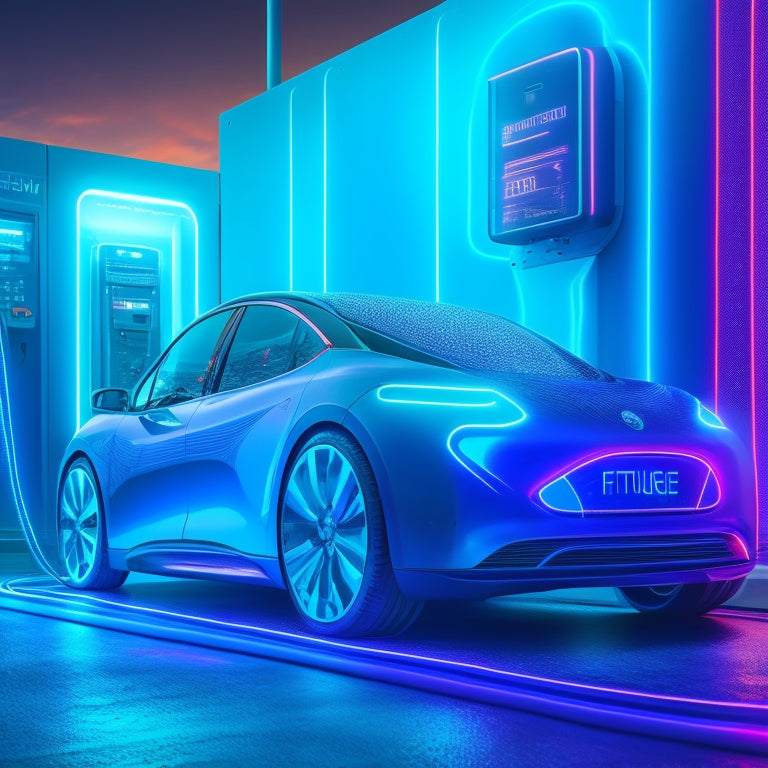
Electric Vehicle Charging With Inverter Technology
Share
By integrating inverter technology into your electric vehicle charging system, you can greatly reduce operational costs and carbon footprint while optimizing energy usage. Inverter technology increases energy efficiency, reduces energy losses, and optimizes power conversion. With features like efficient cooling systems, monitoring, and adjusting system parameters, you can maximize your charging speed and reduce downtime. Leveraging inverter technology enables fast charging capabilities, allowing you to travel longer distances with your EV. As you explore the capabilities of inverter technology, you'll discover more ways to maximize your electric vehicle charging experience.
Key Takeaways
• Inverter technology optimizes electric vehicle charging by increasing energy efficiency, reducing operational costs, and minimizing carbon footprint.
• Efficient power conversion and cooling systems in inverter technology enable fast and reliable EV charging with reduced energy losses.
• Grid-tie inverter functions, such as maximum power point tracking, ensure stable and efficient charging, while also providing backup power and stabilizing peak demand.
• Inverter technology enables high-power charging applications, achieving up to 100 km of range in 10-15 minutes, and reduces battery wear by decreasing charging cycles.
• Real-time monitoring and control features of inverter technology enable precise adjustments, fault diagnosis, and remote access for optimized EV charging.
Commercial Inverter System Benefits
In addition, by integrating a commercial inverter system into your electric vehicle charging infrastructure, you can greatly reduce your operational costs and carbon footprint while increasing energy efficiency.
This advanced technology enables you to optimize your energy usage, resulting in significant cost savings. Additionally, commercial inverter systems are designed to be space-efficient, allowing you to maximize your available space while minimizing your environmental impact.
With a commercial inverter system, you can expect to reduce your energy consumption and lower your electricity bills. By leveraging this innovative technology, you'll be in control of your energy costs and environmental sustainability.
Solar Panel System Design
Designing a solar panel system requires careful consideration of several factors, including the size and type of panels, mounting options, and electrical infrastructure, to guarantee maximum energy harvesting and seamless integration with your electric vehicle charging infrastructure.
You'll need to optimize panel orientation to capture the most sunlight, taking into account your location's latitude and shading factors. Proper cable sizing is also essential to minimize energy losses and ensure efficient energy transmission.
Inverter Technology for EV Charging
As you explore inverter technology for EV charging, you'll discover two critical aspects that greatly impact the charging experience: power conversion efficiency and fast charging capabilities.
You'll want to scrutinize these factors since they directly influence the overall performance and convenience of your EV charging system.
Power Conversion Efficiency
In high-power electric vehicle (EV) charging applications, you can greatly reduce energy losses by optimizing power conversion efficiency through advanced inverter technology. This is important because energy losses can lead to increased thermal management issues, reducing the overall lifespan of your charging system.
To minimize energy losses, consider the following strategies:
-
Enhance inverter design: Selecting the right inverter topology and components can have a substantial impact on power conversion efficiency.
-
Implement efficient cooling systems: Effective thermal management is vital to reducing energy losses and maintaining peak charging performance.
-
Monitor and adjust system parameters: Continuously monitoring and adjusting system parameters, such as voltage and current, helps optimize power conversion efficiency and reduce energy losses.
Fast Charging Capabilities
You can greatly reduce electric vehicle (EV) charging times by leveraging advanced inverter technology that enables fast charging capabilities. This technology plays a crucial role in the development of efficient charging infrastructure, which is essential for widespread EV adoption. Fast charging enables vehicle autonomy, allowing EVs to travel longer distances without needing to recharge.
| Charging Speed | Charging Time | Vehicle Autonomy |
|---|---|---|
| Level 2 (240V) | 4-8 hours | 100-200 miles |
| DC Fast Charging | 30-60 minutes | 200-300 miles |
| High-Power Charging | 15-30 minutes | 300-500 miles |
Grid-Tie Inverter Functions
As you explore grid-tie inverter functions, you'll find that they play an essential role in electric vehicle charging.
You'll discover that these inverters efficiently convert DC power from the vehicle's battery to AC power that's synchronized with the grid, ensuring a seamless charging process.
Now, let's examine the key aspects of grid-tie inverter functions, including the power conversion process, grid synchronization mode, and maximum power point tracking.
Power Conversion Process
During each cycle, the grid-tie inverter's power conversion process efficiently transforms DC power from the electric vehicle's battery into AC power, synchronizing it with the grid's frequency and voltage. You get a seamless shift, ensuring a high Power Quality output. This process involves minimal Conversion Loss, making it an efficient system.
Here's how it works:
-
DC-AC Conversion: The inverter converts DC power from the battery to AC power, synchronized with the grid's frequency.
-
Voltage Regulation: The inverter regulates the output voltage to match the grid's voltage, ensuring a stable power supply.
-
Synchronization: The inverter synchronizes the AC power output with the grid's frequency, allowing for efficient energy transfer.
With this power conversion process, you can rest assured that your electric vehicle is charging efficiently and safely.
Grid Synchronization Mode
In grid synchronization mode, the grid-tie inverter's advanced functionality guarantees a stable and efficient charging process by continuously monitoring and adapting to the grid's frequency and voltage fluctuations.
You can be confident of high power quality as the inverter synchronizes with the grid frequency, ensuring that the charging process is always in harmony with the grid. This mode is critical, as it prevents any disruptions to the grid and ensures a seamless charging experience.
Maximum Power Point
Your grid-tie inverter's maximum power point tracking (MPPT) function guarantees that your electric vehicle charging system extracts the maximum amount of power from the grid, optimizing the charging process and minimizing energy losses. This is achieved through Voltage Optimization, ensuring that the voltage output is adjusted to match the grid's voltage, maximizing power transfer.
Here are three key benefits of MPPT:
-
Power Optimization:
MPPT ensures that your charging system operates at the peak power output, reducing energy waste and increasing charging efficiency. -
Improved Charging Speed:
By maximizing power transfer, your electric vehicle charges faster, getting you back on the road sooner. -
Enhanced System Reliability:
MPPT reduces the risk of overheating and component failure, ensuring a more dependable and durable charging system.
Energy Storage System Integration
By integrating energy storage systems with electric vehicle charging infrastructure, you can optimize the charging process and stabilize the grid by mitigating peak demand and providing backup power during outages.
This integration enables you to store excess energy generated during off-peak hours, reducing strain on the grid during peak hours. With advanced energy storage systems, you can achieve higher energy density, allowing for more efficient charging. This, in turn, enhances grid resilience by providing a buffer against power outages and voltage fluctuations.
Maximum Power Point Tracking
You can further optimize electric vehicle charging by employing Maximum Power Point Tracking (MPPT) technology, which guarantees that the inverter extracts the maximum possible power from the energy storage system. This technology assures that the inverter operates at its peak efficiency, reducing energy losses and maximizing power output.
To achieve this, MPPT uses advanced tracking algorithms to continuously monitor and adjust the inverter's operating point, ensuring the best possible power extraction.
Here are three key benefits of MPPT technology:
-
Improved Efficiency: MPPT technology assures that the inverter operates at its peak efficiency, reducing energy losses and maximizing power output.
-
Enhanced Power Optimization: By continuously monitoring and adjusting the inverter's operating point, MPPT technology optimizes power output, ensuring that the energy storage system is utilized to its full potential.
-
Increased Charging Speed: With MPPT technology, you can charge your electric vehicle faster, as the inverter extracts the maximum possible power from the energy storage system.
Electric Vehicle Charging Speed
Rapid electric vehicle charging is essential for widespread adoption, and inverter technology plays a crucial role in accelerating the charging process.
You need to take into account the charging speed when selecting an electric vehicle (EV) charging system. The charging speed determines how quickly you can recharge your EV's battery, which directly impacts your vehicle's range.
With inverter technology, you can reduce charging times significantly, making it ideal for high-power charging applications. For instance, you can achieve up to 100 km of range with just 10-15 minutes of charging.
This translates to fewer charging cycles, reducing wear and tear on your battery. By optimizing charging speed, you can maximize your vehicle's range and reduce downtime, making electric vehicles a more practical option for daily use.
System Monitoring and Control
Inverter technology's advanced system monitoring and control capabilities enable real-time tracking of charging parameters, allowing for precise adjustments to optimize the charging process and guarantee efficient energy transfer.
You'll have complete control over the charging process, ensuring that your electric vehicle is charged quickly and efficiently. With inverter technology, you can:
- Monitor charging parameters in real-time, ensuring ideal energy transfer.
- Diagnose faults quickly and accurately, minimizing downtime and reducing maintenance costs.
- Access the system remotely, allowing you to control and monitor the charging process from anywhere.
With advanced system monitoring and control, you'll be able to identify and address any issues quickly, ensuring that your electric vehicle is always charged and ready to go.
Inverter Efficiency and Reliability
As you capitalize on the advanced monitoring and control capabilities of inverter technology, maximizing inverter efficiency and reliability becomes essential to sustaining peak charging performance.
You need to guarantee that your inverter system operates within ideal parameters to minimize energy losses and prevent overheating. Effective thermal management is vital in this regard, as it helps to dissipate heat generated during the charging process.
Additionally, incorporating surge protection measures helps safeguard your inverter against voltage spikes and electrical disturbances. By prioritizing inverter efficiency and reliability, you can ensure consistent and reliable charging operations, even in demanding environments.
Frequently Asked Questions
Can Electric Vehicles Be Charged Using Alternative Energy Sources?
You can charge your electric vehicle using alternative energy sources, such as solar power or wind energy, which can be harnessed and converted into electrical energy, providing a sustainable and environmentally friendly option.
How Do Inverters Handle Multiple Vehicle Charging Simultaneously?
"You're about to uncover the secret to charging mayhem - when you plug in multiple EVs, inverters use load balancing and smart power distribution to harmonize energy management, ensuring your grid doesn't implode."
What Safety Features Are Built Into EV Charging Inverter Systems?
When you design an EV charging inverter system, you'll find safety features like ground fault detection, overvoltage protection, electrical isolation, thermal monitoring, and surge protection to guarantee safe and reliable charging operations.
Can Inverter Technology Be Used for Both AC and DC Charging?
You're wondering if inverter technology can handle both AC and DC charging. Yes, it can, by leveraging power conversion capabilities to adapt to varying electrical infrastructure, ensuring charger efficiency, grid stability, and optimized inverter design.
Are Electric Vehicle Charging Inverters Compatible With All Types of Vehicles?
Like a master key fitting perfectly into a lock, you'll find that electric vehicle charging inverters are designed to be compatible with various vehicles, adhering to inverter standards, ensuring seamless vehicle compatibility, regardless of the make or model.
Related Posts
-

Sustainable Scrubbing: Top Bathroom Solutions for Earth-Conscious Homes
You're taking an important step towards creating a more sustainable home by switching to eco-friendly bathroom cleani...
-

Why Grow Up? Vertical Gardens Transform Urban Living
As you change your urban living space, you're not just growing up - you're bringing nature back into the heart of the...
-

10 Powerful Electric Mowers for Expansive Lawns
You're moving away from gas-powered mowers and exploring electric options for your expansive lawn. You'll find that h...


